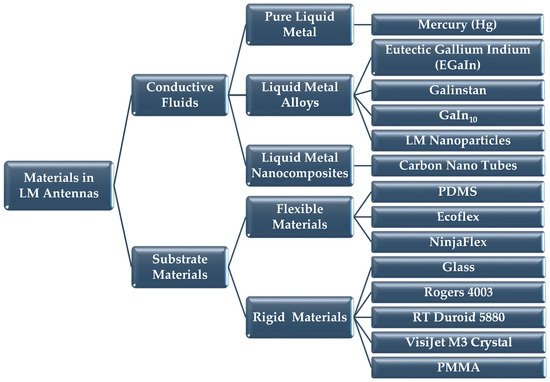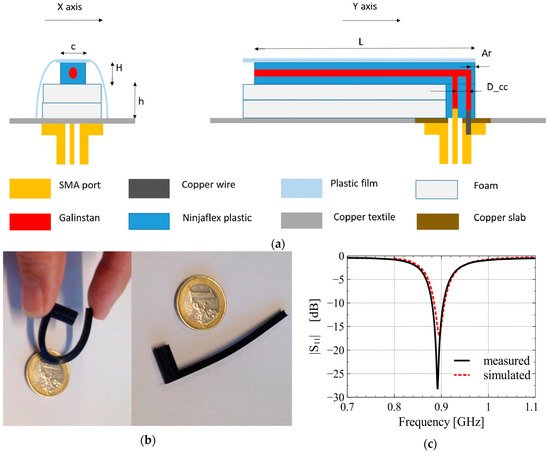International researchers are reviewing structure and design concepts for liquid metal antennas, along with examining and expanding applications where they could prove to be useful. Their findings are outlined in the recently published ‘Liquid Metal Antennas: Materials, Fabrication, and Applications.’
Commonly used in communication devices today, antennas that can be reconfigured are attractive for applications that require a variety of different frequencies in operation, patterns, and polarization. Reconfigurable antennas are usually made with copper—and while such metal offers great efficiency, users are left to deal with inferior mechanical flexibility and ongoing limitations.
With fluid antennas though, mechanical properties of encasing materials are passed on, and the antenna takes on the shape of fluidic channels also—leaving them capable of deforming, whether bending stretching, folding, or twisting—and then reverting to their initial form.
Typical fluidic antennas are categorized as non-conductive, partially conductive, and conductive:
“Non-conductive fluids include de-ionized (DI) water, ethyl acetate, acetone, and various oils such as mineral/transformer oil, which are used in dielectric resonator antennas (DRA). Partially conductive fluids like seawater are also available and typically used in fabricating antennas for maritime applications, while solute concentrations in electrolytic solutions can be used to fine-tune antenna performance,” explained the researchers. “Finally, the third type, which this review focuses primarily on, is conductive fluids. Liquid conductive metals because of their solid-like oxide skin on the surface, impart mechanical stability to the elastomeric antennas and hence, provide flexibility while maintaining high conductivity suitable for antenna applications.”
While other more solid materials are limited in deformation, obviously their fluidic counterparts have no limits, making them useful in combination with rigid conductors due to the flexibility of fluidity and the physical properties associated with conductive fluid materials. The liquid form offers greater freedom and reconfigurability, leaving them most often created on ‘soft and flexible’ substrates for elasticity.
“Such elasticity is not achievable when using solid radiative elements,” state the researchers.

Typical materials used in LM antenna design. Abbreviation: LM, liquid metals; PDMS, polydimethylsiloxane; PMMA, polymethyl methacrylate.
Conductive fluids are usually made of composites or are comprised of liquid metal. Nanocomposites may also be used to increase conductive properties.

Properties of popular conductive fluids used in antenna design. Additional LM material properties are available in [7,19,24]. (Silver nanoink and AgNW added for comparison only). Abbreviation: SWNT, single-walled carbon nanotube; AgNW, silver nanowire.
“Mercury is the only metal available in liquid form at room temperature with melting point of −39 °C and an electrical conductivity of 1 × 106 S/m,” explain the researchers. “It also has good stiction properties and a low oxidation rate, making it a suitable material for developing a liquid antenna. However, mercury is extremely toxic and must be handled with care, resulting in its limited usage in antenna design.”
The authors point out that almost all the fabrication and patterning techniques for conventional antennas can be used with LM antennas; however, LM fabrication is generally defined as one of three types:
- Soft/photo-lithography
- 2D/3D printing
- LM spraying onto the substrate

(a) Fabrication process of the patch antenna using soft-lithography. (b) Front and top view of the fabricated antennas. (c) Comparison of antenna’s simulated and measured radiation efficiency [45]. Abbreviations: PET, polyethylene terephthalate.

(a) Structure of miniaturized inverted F antenna using 3D-printed NinjaFlex plastic; (b) fabricated antenna depicting structural flexibility; (c) measured versus simulated antenna reflection coefficients

(a) Antenna frame generated by UV-assisted direct writing technology on a PDMS substrate; (b) fabricated antenna with EGaIn/SWNTs nanocomposite; (c) H-plane; and (d) E-plane pattern comparison for simulated and measured response
Today, LM antennas are useful in applications such as:
- Skin-attachable motion sensing systems
- Wireless power transfer
- Biomedical implantable devices
- RFID tags
- Handheld cellular devices
“LM-based antennas might not represent a general alternative to standard high-frequency switching techniques used in modern communication devices because of their small electrical conductivities, slow switching speeds and micropump sizes,” concluded the researchers. “However, with recent development of better LM nanocomposites, fabrication/filling methods, and tuning/reconfigurability techniques, LM antennas do show a very promising prospect as part of the larger future 5G network, especially for applications demanding flexible antenna solutions.”
3D printing is being used increasingly more often for the fabrication of antennas, from polymer antennas used in SAR systems to origami-inspired RF antennas, equipment for multi-beam applications, and more.
What do you think of this news? Let us know your thoughts! Join the discussion of this and other 3D printing topics at 3DPrintBoard.com.
[Source / Income: ‘Liquid Metal Antennas: Materials, Fabrication, and Applications’]Subscribe to Our Email Newsletter
Stay up-to-date on all the latest news from the 3D printing industry and receive information and offers from third party vendors.
You May Also Like
New Report: Semiconductor Industry to See $1.4B in 3D Printing Revenues by 2032
“The semiconductor sector has become the most strategically significant area of global industry.” Truer words are hard to come by when it comes to the modern world, and they are...
Will Photonic-Crystal Lasers Revolutionize 3D Printing?
Powder bed fusion (PBF) for metals and polymers predominantly utilizes lasers as the primary heat source. Some directed energy deposition (DED) technologies also employ lasers, while various vat polymerization methods...
3D Printing Unpeeled: Orbex Investment, IndoMIM and HP, Ultrasonic Waves
INDO-MIM has bought three HP Metal Jet S100 printers, operating two in India and one in Texas. This is a win for HP because the company has deep experience in...
3D Printing Webinar and Event Roundup: April 21, 2024
It’s another busy week of webinars and events, starting with Hannover Messe in Germany and continuing with Metalcasting Congress, Chinaplas, TechBlick’s Innovation Festival, and more. Stratasys continues its advanced training...































